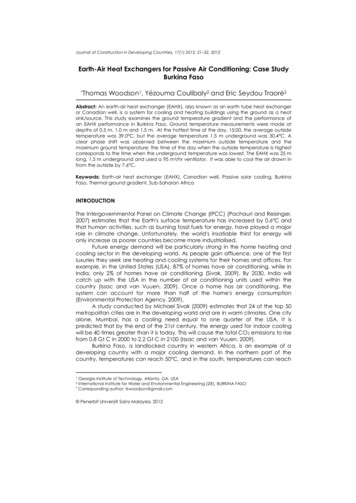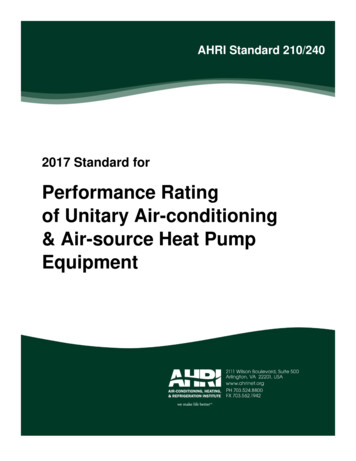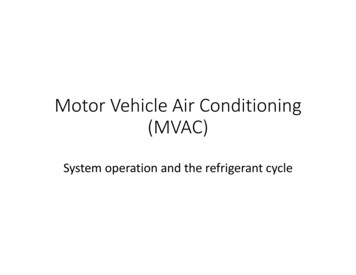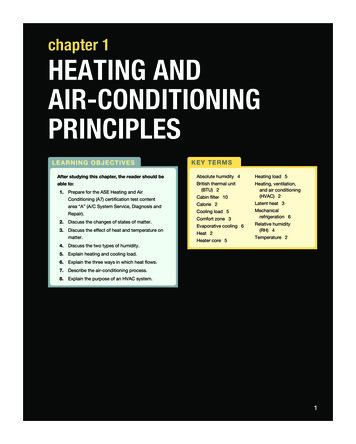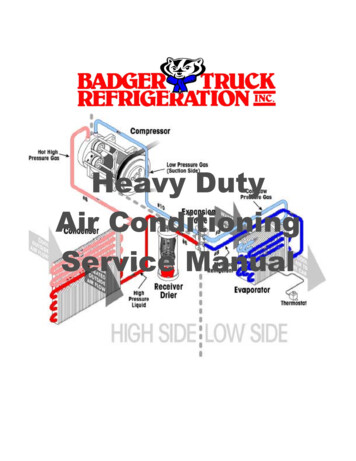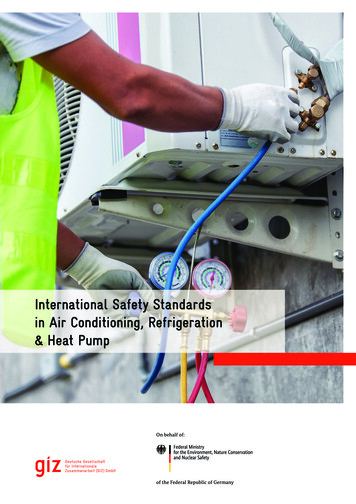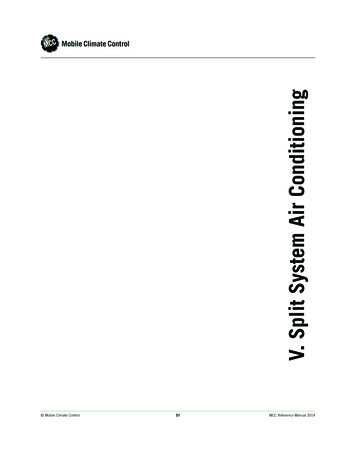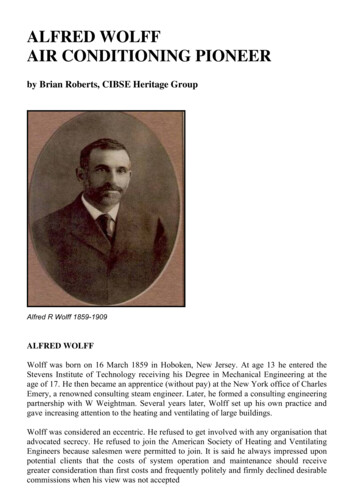
Transcription
ALFRED WOLFFAIR CONDITIONING PIONEERby Brian Roberts, CIBSE Heritage GroupAlfred R Wolff 1859-1909ALFRED WOLFFWolff was born on 16 March 1859 in Hoboken, New Jersey. At age 13 he entered theStevens Institute of Technology receiving his Degree in Mechanical Engineering at theage of 17. He then became an apprentice (without pay) at the New York office of CharlesEmery, a renowned consulting steam engineer. Later, he formed a consulting engineeringpartnership with W Weightman. Several years later, Wolff set up his own practice andgave increasing attention to the heating and ventilating of large buildings.Wolff was considered an eccentric. He refused to get involved with any organisation thatadvocated secrecy. He refused to join the American Society of Heating and VentilatingEngineers because salesmen were permitted to join. It is said he always impressed uponpotential clients that the costs of system operation and maintenance should receivegreater consideration than first costs and frequently politely and firmly declined desirablecommissions when his view was not accepted
Wolff refused to write letters (except in extreme cases), refused to issue work progressreports and avoided using the telephone, leaving such matters to others. He followed astrict moral code and practised business ethics which forbade bribes or kickbacks.Wolff developed heat loss calculations from German methods using what is now termedU-values. He also recognised that internal heat gains, from people and gas or electriclighting contributed to cooling loads and he pioneered the use of air filters.Alfred Wolff’s Design Chart for Determining Heat Transfer Rates for Various Building Materials
Wolff believed in using the latest available design information. Electricity was cominginto widespread use in the 1890’s but it was often more economical to produce on siteusing steam-engine-driven generators with the large quantity of exhaust steam availableto heat the building (co-generation). He also supported the change from steam-drivenfans to DC electric drive and was a believer in the use of thermostatic controls favouringthe Johnson pneumatic system.He employed cooling methods on his projects of this time including Carnegie Music Hallin 1889 (ice block cooling) and Cornell Medical College in 1902 (refrigeration by theCarbondale Company).CARNEGIE MUSIC HALL, NEW YORKCarnegie Hall in 1899Carnegie Hall (known as the New York Music Hall until 1894) was founded by AndrewCarnegie and opened officially on 1st May 1891. The main concert hall was providedwith a seating capacity of 3000, the recital hall beneath this seated 1200. The architectwas William B Tuthill. His design was widely praised for “its acoustical excellence”).In 1986 the Hall underwent a major renovation and restoration.
The ice-block cooling and ventilating system
Carnegie Hall Air Distribution System“The fresh warmed air enters the music hall through numerous perforations in or near theceiling, being forced by two 7-foot Sturtevant blowers which draw it through heaters of1.25-inch pipe containing 6600 square feet of heating surface.”
Carnegie Hall “Heating, cooling and blowing plant”A is the fresh air shaft from the roof (6 x 12 feet supplying distributing chamber G)B is a fan which draws air into the chambers D through the steam radiators HC is an ice rack for use in warm weatherE is an engine driving a fanF is the main air duct (area 30 square feet)P is an iron drip pan, S is a waste pipe: D is a door
Carnegie Hall air inlet chamber detailing the racks for holding ice-blocks for coolingC & O form the ice-racks
Carnegie Hall: View of the fan systemH is a steam heating coil
THE NEW YORK STOCK EXCHANGEAfter the architect George Brown Post, who contributed to the origin and development ofthe early “skyscraper” in the 1870’s, was appointed to design the New York StockExchange, it is said that he expected Wolff to complete all the ventilation drawings intwo weeks. Wolff said that was impossible because the architect’s plans were so complexand in the event it took almost a year. (It is not known how Post felt when Wolff refusedto accept the normal custom that his fee would be a percentage of what the architectreceived and instead negotiated a separate agreement).When Wolff received the plans for the New York Stock Exchange he was confrontedwith a design for one of the largest interior spaces (the Trading Floor) in the city “a blocklong room that would hold 1500 traders, with a skylighted ceiling 72 feet high and anentire wall of windows.” Initially Wolff designed a thermostatically controlled heatingand ventilating system but as he developed the scheme for the Trading Floor (alsoreferred to as the Board Room) he concluded that ventilation alone would be unable tocontrol either the temperature or the humidity.Realising that some form of artificial cooling was necessary, Wolff consulted with HenryTorrance Jr, a well known refrigeration engineer, with whom he had worked before. Theydesigned a mechanical cooling system that Wolff was able to convince the BuildingCommittee was worth an extra cost of 130,000 dollars. The revised mechanical systemdesign employed four high-pressure steam boilers feeding three steam-engine-drivendirect current generators with an output of 750 kW for lighting and electric motors. Theexhaust steam from the generator engines, supplemented by live steam, was used tosupply “13,000 sq ft of direct and 5000 sq ft of indirect radiation,” but perhaps moreimportantly exhaust steam was used to power the aqua-ammonia absorption refrigeratingplant, chilling brine which was pumped to the cooling/dehumidifying coils of the TradingFloor air handling plants. The heating plant was provided with a pneumatic controlsystem.
New York Stock Exchange in 1904 (Library of Congress photograph)
New York Stock Exchange, interior of the main floorNew York Stock Exchange: Refrigerating & Air Conditioning, scheme drawing from 1904
New York Stock Exchange: Refrigerating & Air Conditioning, scheme drawing from 1904
New York Stock Exchange: Refrigerating & Air Conditioning, scheme drawing from 1904
Stock Exchange Basement with Sturtevant fans driven by DC electric motorsWolff’s calculations of 1901 reveal that the plant was designed to lower the TradingFloor temperature “from 85 degF to 75 degF and the relative humidity from 85% to 75%”requiring a cooling plant capacity of 420 tons (1477 kW). He told the BuildingCommittee:“I would like to say the importance of this plan to the upper portion of theboard room is the abstraction of the moisture and the reduction of humidity.I attach less importance to the reduction of the temperature than to theabstraction of the moisture.”The ventilation systems, serving the Stock Exchange, employed eight centrifugal andthree “disk” (propeller) fans, all driven by DC electric motors to deliver five air changesper hour or “200,000 cubic feet per minute of 100% outside air.” The supply air waspassed through “cheese cloth” filter racks, humidified in winter by steam coil water pansand tempered by steam heating coils. It is recorded that the exhaust air systems had anextract rate of “224,000 cubic feet per minute.”Few comfort cooling systems had been designed before 1901 and the proposed WolffTorrance plant was a giant of its time employing three ammonia absorption brine chillerswith a cooling capacity of 450 tons of refrigeration (1582 kW). The Trading Floorcooling load was 300 tons (1055 kW). The additional 150 tons was designed to serve theunderground basement areas removing machinery and boiler heat with a small amountused to cool drinking water. Waste water from condenser cooling was stored in roofcisterns and used to flush toilets. The Stock Exchange opened on 22 April 1903.
THE CARBONDALE MACHINE COMPANYThe capacity of the refrigerating plant was reduced to 300 tons (1055 kW) prior toinstallation and arranged to serve only the Trading Floor. The refrigeration manufacturerwas the Carbondale Machine Company of Pennsylvania using an improvement to theoriginal English Pontifex patents which they had purchased in 1882.
The Carbondale Machine Company (From Refrigerating Engineering, December 1934)
Wolff was also involved in other projects in New York. He was a consulting engineer forthe design and installation of power plants for the New York Steam Company (later ConEdison) a pioneer in the provision of district heating networks. He also designed manyimportant projects of the time, including the Siegel-Cooper Department Store, the HotelAstoria (which later merged with the Waldorf Hotel to form the Waldorf Astoria), StLuke’s Hospital, the New York Life Insurance Building and the Metropolitan LifeBuilding.The New York Life Insurance Building “was heated by steam from four water-tubeboilers distributed through direct and indirect radiation. The system was controlled bythermostats from the Johnson Electric Service Co. The first seven floors were heated byindirect radiation to 70 in zero weather with a pressure of not more than five pounds bymeans of two central heating stacks and two of B F Sturtevant’s 7-foot ventilating fans.Air filters clean all entering air from soot and dust . For indirect radiation Bundyloop radiators and coils are used (A A Griffing Iron Co, Jersey City). Radiators areplaced in halls, vestibules and toilets.Around 1904, Wolff “adopted a different device for ventilating tall buildings (for)the Hotel St Regis (New York), fifteen storeys high and pretty thorough ventilation waswanted. Fresh air ducts equal to the requirements of the various floors would be so largeon the lower floors that a wholly impracticable proportion of floor space throughout thebuilding would be sacrificed to air ducts if the plant was in the basement. Mr Wolff,therefore, divided his ventilating plant into batteries of four, placing one unit each in thebasement, third, seventh and twelfth floors, with indirect stacks supplied with steam bypipes from the boiler in the cellar.”Wolff was also the consultant for a number of large residences, including the CorneliusVanderbilt II house and the John Jacob Astor IV house. In Vanderbilt’s house, theheating and ventilation was provided entirely by a gravity-type ducted air distribution,fans being used only for exhaust, with hot water boilers as the heating source. A similarsystem was employed in the Astor House.
The Siegel-Cooper Department Store in New York 1896St Luke’s Hospital, New York
The New York Life Insurance Building 1894-98
St Regis Hotel, New York, 1904
Metropolitan Life Insurance Building & Tower (left), New York 1909Workers in the former Metropolitan Life Insurance Building in 1896 (note lamps at each station)Replaced by the New Building & Tower of 1909 on the same site
Typical floor plan of the entire complex, Metropolitan Life Building 1909The tower is the small square in the upper left-hand cornerCornelius Vanderbilt II house in New York 1892
The John Jacob Astor house in New York 1892
BIBLOGRAPHY1896 Ventilation and Heating, John S Billings: The Engineering Record, London1897 Heating and Ventilating Plants in a few conspicuous New York Buildings, Anonymous, Heatingand Ventilation, p.6, VII (6)1904 Heating and Ventilating Magazine, October (Hotel St Regis)1934 What the Refrigerating Machine Companies Have Contributed: The Carbondale MachineCompany, pp. 299-300, Refrigerating Engineering, December1990 Alfred Wolff -HVAC Pioneer, Bernard A Nagengast, pp.S66-S80, ASHRAE Journal, January1991 Mechanical & Electrical Systems for Historic Buildings, Gersil Newmark Kay, pp141-143,McGraw-Hill, (Drawings from The Engineering Record, April 1905)1994 Heat & Cold: Mastering the Great Indoors, Barry Donaldson & Bernard Nagengast, pp. 271-276& 281, ASHRAE1995 The Encyclopedia of New York City, Kenneth T Jackson (Ed), Yale University Press &The New York Historical Society1995 Proclaiming the Truth, ASHRAE Centennial Publication2000 The Comfort Makers, Brian Roberts, ASHRAE2014 Cool: How Air Conditioning Changed Everything, Salvatore Basile, pp .67-70, Fordham UP
POSTSCRIPT: FUTHER READING199119951996
1994
EPILOGUEAt the height of his career, Alfred Wolff became ill and died suddenly on 7 January 1909at the age of 49. Wolff’s design for the New York Stock Exchange air conditioningsystem operated successfully for nearly 20 years before it was modernised. It has greaterclaim to be the first scientifically designed air conditioning system than Carrier’s SackettWilhelms plant of 1902 which was not entirely successful being removed after a fewyears,
AIR CONDITIONING PIONEER by Brian Roberts, CIBSE Heritage Group Alfred R Wolff 1859-1909 ALFRED WOLFF Wolff was born on 16 March 1859 in Hoboken, New Jersey. At age 13 he entered the Stevens Institute of Technology receiving his Degree in Mechanical Engineering at the age of 17. He then became an apprentice (without pay) at the New York office of Charles Emery, a renowned consulting
